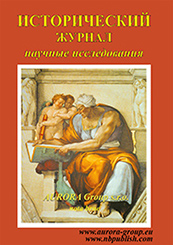THEORY AND METHODOLOGY OF HISTORY RESEARCH
Reference:
Ershova G.G. (2011). New approaches to the study of written cultures of the New World in the light of the
calendar “the phenomenon of 2012”. History magazine - researches, 3, 5–15. https://en.nbpublish.com/library_read_article.php?id=58360
Abstract:
The hieroglyphic inscription of the classical period on the Mayan Monument 6 of the settlement of El Tortuguero
(Mexico) contains the date corresponding to the year 2012, which have led to the appearance of the so-called “phenomenon
of 2012” in the last decade. Reading ancient texts requires a special approach, the basis for which has been developed by the
decoder of Maya letters V. Knorozov. Reading a hieroglyphic text on the monument 6 with relation to other textual sources
allowed to determine that the so-called “prophecy” is nothing more than a designation of the position of the Mars in its
synodic (unlike sidereal) period at the time of the date 13.0.0.0.0 in the calendar entry of the Maya.
Keywords:
“The phenomenon of 2012”, the El Tortuguero site, Mesoamerica, the Maya civilization, the Maya hieroglyphic writing, the texts of the Maya, codes of the Maya, calendar, astronims, ancient astronomy, Mars, mythology, world model, the ancient scientific knowledge, ethno-semiotic, the methodology of ancient texts reading.
Interdisciplinary research
Reference:
Dolgova E.A. (2011). “Synthesis of all higher and eventual results of human sciences…”: on the integral
tendencies in the Russian social sciences in the first quarter of the XX century (experience
of educational and research centers). History magazine - researches, 3, 16–22. https://en.nbpublish.com/library_read_article.php?id=58361
Abstract:
The author studies the synthesis of the humanities in the Russian science in XIX–XX centuries. One of
the topics, which is considered in this article, is a synthesis of history, sociology and psychology in the practice of several
educational and scientific centers: Russian School of Social Sciences in Paris, Psychological Institute named after
V.M. Bekhterev, Russian Sociological Society named after M. Kowalewsky. The author concludes that the interdisciplinary
approach had been implemented more consistently in the teaching process (curricula) of these centers and it had not
received sufficient development in their scientific activities.
Keywords:
history, sociology, psychology, social science, education, synthesis, humanitarian, knowledge, theory, methodology.
HISTORIOGRAPHY AND SOURCE STUDIES
Reference:
Pashkina E.G. (2011). Self-consciousness of the “Order of the Russian Intelligentsia” (based on the materials
of Russian emigration journal “Noviy Grad”). History magazine - researches, 3, 23–26. https://en.nbpublish.com/library_read_article.php?id=58362
Abstract:
The “Noviy Grad” journal was published in Paris from 1931 to 1939, and it was a publication that
reflected the views of Fedotov G.P. (1886-1951), Berdyaev N.A. (1874-1948), Stepun F.A. (1884-1965) and many other
leading thinkers of the emigration. The journal was financed by the American protestant organization YMCA (Young
Men Christian Association). Many authors of the journal were members of the Order of the Russian intelligentsia,
they believed in fate of Russia. In an effort to reestablish the Order, the “Noviy Grad” members dreamed of a victory over
the Bolsheviks, relying on the Soviet intelligentsia, who, joining the culture of the Order, eventually had to gain self-awareness of the elite and take the path of fighting against the Bolsheviks, undermining the spiritual foundations of the
Soviet system with various ideological currents of emigration.
Keywords:
history, Russian, emigration, Order of the Russian Intelligentsia, “New Town”, YMCA, Fedotov, Berdyaev, Stepun, consciousness.
Historical facts, events, phenomena
Reference:
Zakharov V.V. (2011). In the face of the decisive battle: the Red Army and the German Wermacht in 1939–1941. History magazine - researches, 3, 27–36. https://en.nbpublish.com/library_read_article.php?id=58363
Abstract:
The article reveals the condition of the Red Army and the German Wehrmacht in the pre-war period of
1939–1941. The strengths and weaknesses of the Red Army and the German Wehrmacht, as well as the composition of the
opposing factions and the plans of both parties on the eve of the war are shown in this article.
Keywords:
history, war history, Red Army, Wermacht, Second Word War, Stalin, Hitler, pact, Barbarossa, first strike.
Historical time and space
Reference:
Kochelyaeva N.A. (2011). The pilgrimage of hieromonk Barsanuphius to Jerusalem, Egypt and the Sinai
in the second half of the XV century. History magazine - researches, 3, 37–47. https://en.nbpublish.com/library_read_article.php?id=58364
Abstract:
The article is devoted to the two significant literary monuments of Russian pilgrims’ literature, which were
written by a celibate priest Barsanuphius in the second half of XV century. The first pilgrimage to the Jerusalem is usually
not studied by scientists who specialize in studying the literature of pilgrimage, but this work is of undoubted interest to the
artifacts study, because it contains detailed information about the Christian holy places of Palestine. Second pilgrimage
gained popularity among researchers, because it is the first Russian description of Egypt and the Sinai.
Keywords:
history, pilgrimage, travels, sources, artifacts, Christian, East, Old Russian, literature.
History of ethnicities, peoples, nations
Reference:
Samutkina L.A. (2011). Germans in the early Byzantine chronicles. History magazine - researches, 3, 48–55. https://en.nbpublish.com/library_read_article.php?id=58365
Abstract:
The article analyzes the ideas of a German-Roman world of the Byzantine chronicler of the VI century Ioannes
Malals, and the anonymous author of “Paschal Chronicle” in the VII century. Basic models of the interpretation of the
history of the main Germanic tribes (Goth, Vandals, Franks, Herulians) and their role in the history of the Roman Empire,
as presented in the historical writings, are represented. The author also analyzes the characteristics of representation f the
leading characters of the German-Roman history in the early Byzantine chronicles, especially of Theodoric the Great as a
keeper of an idea of the Germanized Roman Empire.
Keywords:
history, early Byzantium, chronicle, semeiotic method of analysis, Ioannes Malals, “Easter chromicle”, Teutons, vandals, the Visigoth, the Ostrogoth.
Issues of war and peace
Reference:
Volkov V.A. (2011). 1611: first militia, the beginning of the Battle for Moscow. History magazine - researches, 3, 56–63. https://en.nbpublish.com/library_read_article.php?id=58366
Abstract:
The article is devoted to the 400th anniversary of the establishment of the First national militia, which
started the fight for the liberation of Moscow. The article deals with the prehistory of the organization of military forces,
and with its first campaigns and battles. A brief description of militia leaders Lyapunov P.P., Trubetskoy D.T., Zarutskiy
I.M. is also given.
Keywords:
history, the Time of Troubles, Polish intervention, state movement, militia, military forces, Council of seven boyars, Lyapunov, Zarutskiy, Trubetskoy.
Culture and cultures in historical context
Reference:
Kofman A.F. (2011). Spanish conquistador in the stream of history. History magazine - researches, 3, 64–72. https://en.nbpublish.com/library_read_article.php?id=58367
Abstract:
The article discusses the features of historical thinking of the Spanish conquistadors — people, who were
born in the crossing of epochs, spaces and cultures, and who embodied the traits of a crucial era of the Middle Ages to
the New Era. As heirs of the medieval way of thinking and culture, they verbally professed Christian fatalism, which
was inseparable from the faith in God’s favor and miracle. In fact, by personal example they have asseverated the
effectiveness of individual effort and goal setting, which opened a vast aria for personal initiative, and was embodied
in the act that summed anthropocentric concepts and ideas that fed the spirit of the Renaissance. They understood the
course of historical process, and themselves as its driving force, and they have become outstanding representatives of the
Renaissance type of person.
Keywords:
history, New world, conquistador, Conquista, fatalism, Voluntarism, the discovery, historicism, memory, glory
CULTURAL HERITAGE - HISTORICAL AND CULTURAL ARTEFACTS
Reference:
Borodkin L.I., Rumyantsev M.V., Lapteva M.A. (2011). All-Russian scientific seminar “Virtual reconstruction of the historical and cultural
heritage in the forms of scientific researches and educational process”. History magazine - researches, 3, 73–76. https://en.nbpublish.com/library_read_article.php?id=58368
Abstract:
The article provides information on scientific and methodological workshop, held on 22-23 April
2011 in Krasnoyarsk, which was organized by the Humanities Institute of Siberian Federal University (SFU) and the
Association of History and the computer and focusing on the following issues: reality and perspectives in the use of
virtual reconstruction methods in the research activities; the results of the use of virtual reconstruction in the educational
process; the possibility of using virtual reconstruction in scientific and educational activities of museums, educational
centers, and others; problems associated with the characteristics of complex use of different sources during the development
of virtual reconstructions.
Keywords:
history, historical and cultural heritage, cultural artifacts, virtual reconstruction (VR), 3D-modeling, research experience, using virtual reconstruction in educational process, the possibility of using virtual reconstruction in scientific and educational activities, the task of creating virtual resources for Russian cultural artifacts, technologies of representation of virtual resources for cultural artifacts.
Industrial era, postindustrial world
Reference:
Krivushin I.V. (2011). Labour stronghold in danger: Scottish nationalists’ political attack on Glasgow
in the late XX – early XXI century. History magazine - researches, 3, 77–91. https://en.nbpublish.com/library_read_article.php?id=58369
Abstract:
The political struggle among the parties in Glasgow in the late XIX – the beginning of the ÕÕI century. The
stages of «laborisation» of urban policy in the XX century is studied. The article analyzes the reasons for political strengthening
of the Scottish Nationalists in Glasgow at the end of XX century – the beginning of the XXI century.
Keywords:
history, Scotland, Glasgow, political struggle, the Labor Party, the Scottish Nationalists, Scottish National Party, the Westminster, Holyrood, the regional council.
ECONOMIC HISTORY, ENTERPRENEURIAL HISTORY
Reference:
Pavlova N.N. (2011). “The Moscow Manchester”: Morozov’s Bogorodsk-Glukhovsk manufactory (1847–1917). History magazine - researches, 3, 92–111. https://en.nbpublish.com/library_read_article.php?id=58370
Abstract:
The article is devoted to the history of Morozov’s Bogorodsk-Glukhovsk manufactory, which is near Bogorodsk
(Noginsk). Seventy years of business activity of this largest cotton factory in Russia won an international recognition as the
Moscow Manchester manfactory allows us to trace the circumstances of forming of the largest center of cotton production
around Moscow and, broadly speaking, the peculiarities of the industrial modernization of Central Russia.
Keywords:
History, Morozovs, cotton production, entrepreneurship, Glukhovo, Bogorodsk, Manchester, manufacture, Old Believers, modernization.
REVIEWS, BIBLIOGRAPHY
Reference:
Koshman L.V (2011). Essays on the history of Sergiev Posad. The end of XVIII—XX century.
Executive editor: Shulepova E. A. M.: ROSPEN, 2011. History magazine - researches, 3, 112–114. https://en.nbpublish.com/library_read_article.php?id=58371
Abstract:
The refereed collective work “Essays on the history of the town of Sergiev Posad. The end of the XVIII—
XX century.” is a study of the socio-cultural and social environment of one of the oldest Russian cities. The work is based on
a wide range of sources and literature. One of the scientific merits of this research is a technique of inspection of the urban
environment and description of its current state developed by the authors. Elected perspective study of using this technique
can be considered a form of translation and study of cultural heritage.
Keywords:
history, regional historical and cultural study, cultural studies, social and cultural studies, socio-cultural environment of the city, historical regional studies, cultural heritage, historic cities of Russia, the history of the Sergiev Posad, the history of the Laura of the Holy Trinity and St. Sergius.
 This work is licensed under a Creative Commons Attribution-NonCommercial 4.0 International License.
This work is licensed under a Creative Commons Attribution-NonCommercial 4.0 International License.
 Eng
Eng












 © 1998 – 2025 Nota Bene. Publishing Technologies. NB-Media Ltd.
© 1998 – 2025 Nota Bene. Publishing Technologies. NB-Media Ltd.




